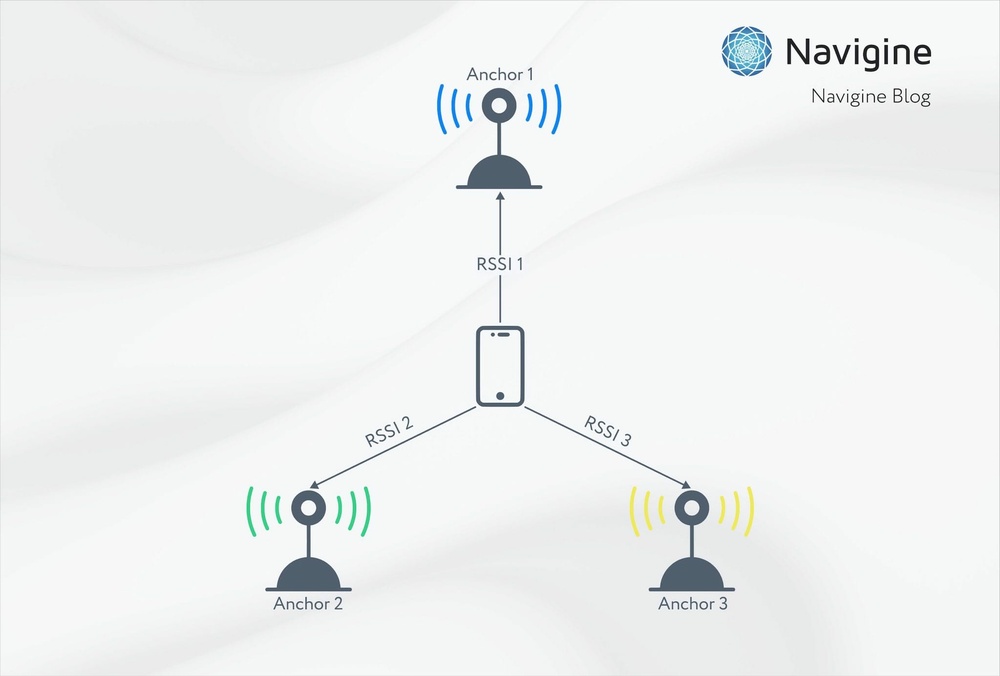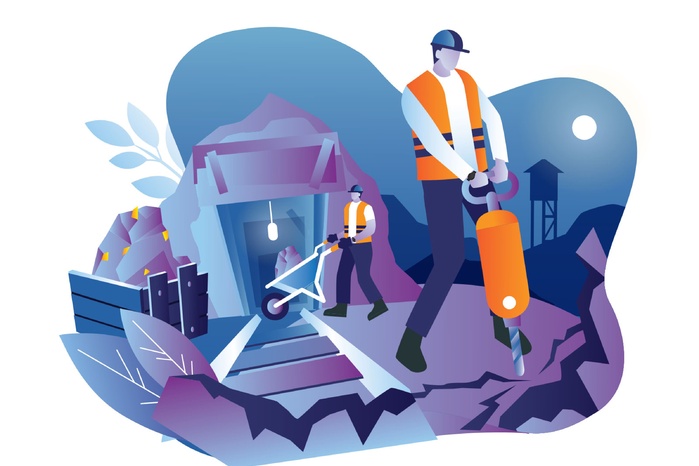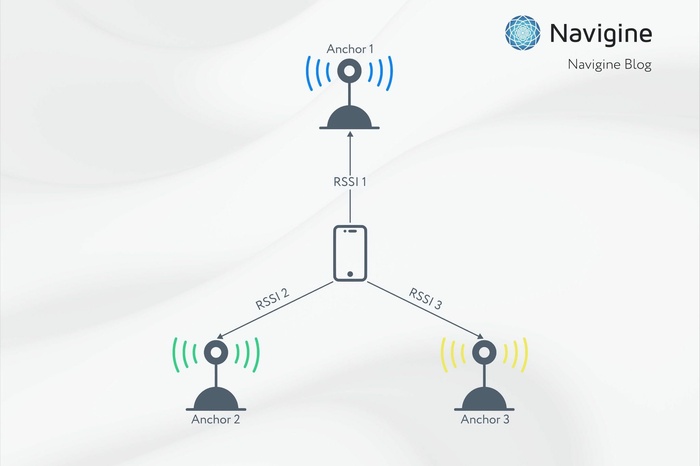Introduction
The Navigine Team uses various techniques and methods to accurately locate the position and movement of assets, inventory, and employees inside facilities. In the dynamic realm of indoor positioning and tracking, the Bluetooth RSSI-based method (the Received Signal Strength Indicator) is one of the most popular technologies, offering insights into the intricacies of signal strength within confined environments. While the RSSI-based method is widely recognized, it is accompanied by several limitations that will be discussed in detail in this article.
The Navigine Blog explores various methods of positioning, as we delved into their peculiarities in the following articles “Zone-based Localization Algorithm”, “All about Particle Filter” and many others. Now we would like to tell you more about the RSSI-based method, touching upon its main capabilities, characteristics, strengths, and limitations.
Definition of RSSI: A Metric for Measuring Signal Strength
Prior to delving into both its potential and constraints, it is essential to offer a concise overview of RSSI to define its usage for indoor tracking and positioning scenarios. The Received Signal Strength Indicator is a fundamental metric, serving as a quantitative measure of the strength of a received radio signal. It allows us to calculate the distance between the emitter of radio signals and the receiver depending on the strength of the received signal. Typically expressed in decibels (dB), this metric plays a crucial role in assessing the quality, reliability, and overall performance of wireless connections.
In the realm of indoor positioning, the RSSI is also actively used to evaluate the position and even movement of various objects within a facility, where the GPS signals can’t work properly. The logic is quite simple: a higher RSSI value signifies a stronger and more robust signal, indicating optimal communication conditions and consequently giving us an opportunity to track the position of an object, based on the metric. Conversely, a lower RSSI value suggests a weaker signal, which may lead to potential challenges such as signal dropout or decreased data transmission rates.

Radio signals that use RSSI as one of the measurements are Bluetooth Low Energy protocol (BLE) and Wi-Fi IEEE 802.11 standard. In the BLE domain, the RSSI is used for relative signal strength estimation and for distance estimation as well. RSSI can be used as a signal quality measurement. For example, devices can optimize power rates or change the transmission power depending on an RSSI threshold. Also, RSSI values are used during the connection process between BLE devices that allows one to estimate the connectivity in a pairing process.
In Wi-Fi protocol, RSSI is used for similar purposes as in BLE, but it also can be used for signal strength mapping to optimize the Wi-Fi network coverage. Therefore, it can also be used for Wi-Fi diagnostics and understanding network issues.
Since RSSI represents a linear representation of the received signal power in dBm (decibels per milliwatt), the values are negative and the closer it gets to the 0, the better is the quality of signals.
Average values of RSSI vary from -80 to -30 dBm, where -30 dBm is measured around the closest possible position to the transmitter of the signals.

RSSI value is It's generally calculated using the following formula: RSSI (in dBm) = Received Signal Power - Noise Floor + Calibration Factor where Received Signal Power is the power of the received signal. Noise Floor represents the background noise level. Calibration Factor accounts for hardware-specific adjustments.
In some cases, the hardware or software might map the received signal strength to an RSSI value based on a predetermined scale or mapping function. This mapping can be vendor-specific and may not directly correlate with the actual received power.
Bluetooth RSSI in Indoor Positioning and Tracking: How Is It Used?
Indoor positioning and tracking solutions have become increasingly important in various fields, ranging from retail and healthcare to logistics and smart homes. In this context, Received Signal Strength Indicator (RSSI) serves as a parameter for estimating the location of BLE devices within confined indoor spaces. The popularity of the RSSI-based method stems from its simplicity, making it applicable to virtually any device employing diverse wireless communication technologies. The calculation of distance is achieved through disparities in the arrival time of packets at various receivers and involves gauging the signal strength of received packets. This method is frequently employed to ascertain the distance between the transmitter and the receiver, leveraging the observable decrease in signal strength as the signal extends outward from the transmitter.
Whether employed in a large warehouse or small retail store, the working principles of the Bluetooth RSSI-based tracking are quite simple. One has to ensure the following components of the overall system to effectively track all necessary assets within your facility:
- Devices such as tags or smartphones capable of transmitting signals.
- Dedicated receivers or gateways designed to receive signals from the tags or smartphones.
- Specialized RTLS software, such as the Navigine Tracking Platform, capable of processing all collected data and presenting it in an easily understandable format.
Bluetooth RSSI in Indoor Positioning and Tracking: Positioning Algorithms
There are multiple positioning algorithms that use an RSSI-based approach to calculate the distance between the transmitter and receiver of a radio signal. A fundamental mathematical model that is used for calculations is a log-distance path loss model. The equation of a loss function is the following: P(d) = A − 2B log(d) P — received signal strength (signal power)
d — distance between a transmitter and a receiver of the signal
A, B — model parameters, individual for each transmitter.
By default, A = -82.0, B = 3.0. These are characteristics of transmitters that represent signal propagation. Deriving the distance from the formula above makes it possible to calculate the desired result.
There are methods for a coefficient reconstruction that allows one to tune coefficients to their real values from default. The algorithm analyzes the logs recorded in the environment with an installed set of transmitters and finds the best values for A and B that allows one to get better quality of navigation.
The measured distance is used in the calculation of the particle weight w in Particle Filter. As it is described in the article about PF, particles represent states of a positioning object, including coordinate and speed. Each particle is assigned a weight that serves as a statistical probability of an object being in a specific state for a given signal strength.
Where P – probability,
sj - strength of signal received from a transmitter j.
sj - strength of signal calculated according to a signal propagation model.
In the end, the position is calculated as a weighted average of positions of particles:
Where N – number of particles sampled,
xi – position of i-th particle
To sum up, the log-distance model helps to estimate signal strength over varying distances, aiding in location-based services where distance estimation from RSSI measurements is required.
What can you expect from the RSSI-based method?
Indoor Positioning and Tracking solutions powered by the Received Signal Strength Indicator (RSSI) method present location-powered capabilities, providing us with the way to understand and navigate indoor environments. Initially, the RSSI-based approach offers what is commonly referred to as "zone-level" accuracy within indoor or confined settings. This implies the capability to track objects on a map with precision extending to several meters. Such an accuracy level proves suitable for a range of scenarios where submeter precision is unnecessary. Examples include applications like geomarketing in retail and shopping malls, as well as equipment tracking and staff monitoring in logistic facilities, among others. Although for use cases where the precise positioning of assets is essential, “zone-level” accuracy presented by the RSSI method may be insufficient.
So what are the key features of the RSSI-method and why is it popular despite various limitations in terms of accuracy and usage scenarios?
First of all, one of the RSSI method’s notable advantages is its cost-effectiveness. Implementing RSSI-based systems typically requires minimal additional hardware, as it leverages the existing infrastructure of devices with wireless communication capabilities. This accessibility makes it an attractive solution for a wide range of industries. However, these devices may have varying power levels, configurations, and sensitivity to environmental conditions that can affect the precision and lead to inaccuracies in RSSI measurements. Additionally, specialists tend to name the versatility of the RSSI method as one of the key advantages, as RSSI is not confined to a specific wireless technology and can be utilized with various protocols such as Wi-Fi, Bluetooth, and RFID. But the thing is that the RSSI-based method also depends very much on the environment and may require periodic calibration as the specific details of the environment change.
So, despite its cost-effectiveness and relative versatility, the method also presents various limitations that should be considered when choosing the technology for integrating solutions of Indoor Positioning or RTLS.
Limitations
- Signal Interference: RSSI-based measurements can be affected by various sources of interference, such as walls, furniture, and other obstacles. The signal strength may fluctuate even if the object being tracked remains stationary.
Walls, furniture, metal objects and other physical obstacles and barriers in an indoor environment can absorb or reflect radio frequency signals. When these signals encounter such obstacles, they may experience attenuation or reflection. Signals can take multiple paths to reach the receiver leading to changes in signal strength. This phenomenon is particularly problematic for RSSI-based tracking, as the received signal may be stronger or weaker than expected due to the combination of different signal paths. Moreover, an indoor environment can be dynamic, which means that people can move objects within the confined space. In this matter, you have to be really careful, when placing hardware infrastructure in a facility to reach the optimal performance of your indoor tracking solution. - Level of Positioning Accuracy: Bluetooth RSSI-based approach can provide zone-level accuracy of indoor positioning and tracking. The zone-level tracking is typically limited to identifying which predefined zone an object is in. Defining clear boundaries for zones can be challenging. In this case, you can face challenges in the areas on the border of the zone related to ambiguity about whether an object is in one zone or another.
- Hardware Usage Issues: RSSI-based tracking in large facilities or spaces may require a dense deployment of hardware (access points, or gateways) to ensure sufficient coverage and performance. Consequently, in large or complex indoor spaces, a sparse deployment of access points may lead to gaps in coverage, resulting in areas where the tracking system cannot effectively determine the location of objects.
- Limited Z-axis Resolution: Zone-level tracking is often better suited for horizontal tracking (X and Y axes) rather than vertical tracking (Z axis). Determining the precise height or floor level of an object within a zone can be challenging. Zone-level tracking systems may lack the precision required to determine the exact height or floor level of an object within a zone. The vertical dimension introduces additional complexities, including signal attenuation due to objects or structures in the environment. Zone-level tracking, provided with help of RSSI signals, may not provide sufficient context about the purpose or activity associated with vertical movement. For example, it may not distinguish between a person using stairs for a workout versus someone simply changing floors.

RSSI vs. AoA (Angle of Arrival)
As we already stated, the RSSI-based method is a popular and effective instrument to create location-based solutions for various industries. But it often comes with multiple limitations, such as signal interference, level of positioning accuracy, hardware usage issues and limited Z-axis resolution.
In the animations above one can see the comparison between tracking solutions for BLE AoA and RSSI methods. In both cases, the starting and ending points are the same. The real trajectory of a device can also be considered identical. In the RSSI animation, you can see that the trajectory of a green pin which resembles a calculated movement trajectory is moving from one locator (icon L on the map) to another. In the BLE AoA tracking animation, you can see that the pin is moving as closely as possible to the real trajectory (red icon X on the map) and is never tailing away from it for more than 1.5 meters.
One of the key differences between these methods is the Constant Tone Extension (CTE) which is a feature introduced in the Bluetooth Low Energy (BLE) standard, specifically in Bluetooth 5.1, to support Angle of Arrival (AoA) and Angle of Departure (AoD) for enhanced direction finding. CTE is used to improve the accuracy of direction finding in BLE by extending the duration of a continuous wave transmission in BLE packets. It allows one to have a better angle estimation by continuously transmitting a tone for an extended period, enabling devices to measure the phase differences between received signal samples. By using CTE, devices can perform more precise angle estimation by analyzing the phase shifts in the received signals, allowing for better accuracy in determining the angle of arrival.
Consider an array of antennas spaced apart at known distances. The phase differences between signals received by these antennas can be used to estimate the angle of arrival. The formula to estimate AoA might involve:
λ – the wavelength of the received signal
d – the spacing between antennas
Δϕ – the phase difference between received signals.
Signal processing methods, such as MUSIC (Multiple Signal Classification) algorithm or Maximum Likelihood Estimation (MLE), can be employed to estimate AoA and subsequently determine the location of the transmitter based on AoA information from multiple receivers.
RSSI and AoA methods both enable location determination through Bluetooth®, yet they operate on distinct principles. AoA relies on the angle of arrival, while RSSI measures the signal power emitted by transponders on tracked assets. Analogous to the diminishing waves from a stone tossed into water, RSSI performance mirrors a decrease in signal strength with increasing distance.

There are several key differences between these 2 methods:
- The RSSI method is a measure of the power level received by a receiver from a transmitter. It indicates the strength of the received radio signal. On the other hand, AOA is a technique that determines the angle from which a signal is arriving at the receiver. It measures the direction of the incoming signal. The RSSI tracking relies on the strength of the received signal. A higher RSSI value generally indicates a shorter distance between the transmitter and the receiver. AoA relies on the angle of arrival of the signal. By using multiple antennas or an antenna array, the system can determine the direction from which the signal is coming.
- The level of positioning accuracy is also different. RSSI can be less accurate in indoor environments due to signal reflections, multipath effects, and interference.
AoA has the potential for higher accuracy, especially in environments with obstacles, as it can mitigate multipath effects by focusing on the direct signal path. So, if your project requires a high level of positioning accuracy, the Bluetooth® Low Energy AoA can be a better, but more expensive option, as it usually requires multiple antennas or an antenna array, which may increase hardware complexity and cost. - Both methods use different protocols. For example, the Bluetooth® AoA protocol utilizes the most recent Bluetooth 5.1 standard, whereas Bluetooth® RSSI necessitates a minimum of Bluetooth 4.0 or higher.
In summary, while RSSI is simpler and more cost-effective, AOA has the potential to provide more accurate and reliable positioning information, especially in challenging indoor environments. The choice between the two depends on factors such as accuracy requirements, environmental conditions, and cost considerations. Some systems may even combine both RSSI and AOA to leverage their respective strengths.
Ready to explore the world of indoor positioning further? Have questions or need additional information? Fill out our feedback form below and schedule a personalized online call with our experts.






